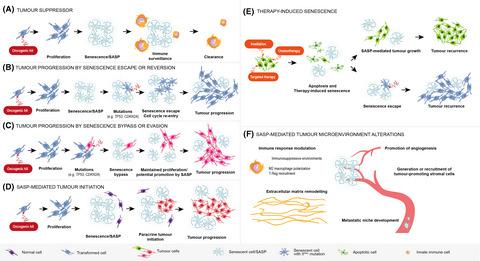当前位置:
X-MOL 学术
›
Neuropathol. Appl. Neurobiol.
›
论文详情
Our official English website, www.x-mol.net, welcomes your
feedback! (Note: you will need to create a separate account there.)
Cell Senescence in Neuropathology: a Focus on Neurodegeneration and Tumours
Neuropathology and Applied Neurobiology ( IF 4.0 ) Pub Date : 2021-02-01 , DOI: 10.1111/nan.12689 Gabriela Carreno 1 , Romain Guiho 1 , Juan Pedro Martinez-Barbera 1
Neuropathology and Applied Neurobiology ( IF 4.0 ) Pub Date : 2021-02-01 , DOI: 10.1111/nan.12689 Gabriela Carreno 1 , Romain Guiho 1 , Juan Pedro Martinez-Barbera 1
Affiliation

|
The study of cell senescence is a burgeoning field. Senescent cells can modify the cellular microenvironment through the secretion of a plethora of biologically active products referred to as the senescence-associated secretory phenotype (SASP). The consequences of these paracrine signals can be either beneficial for tissue homeostasis, if senescent cells are properly cleared and SASP activation is transient, or result in organ dysfunction, when senescent cells accumulate within the tissues and SASP activation is persistent. Several studies have provided evidence for a role of senescence and SASP in promoting age-related diseases or driving organismal ageing. The hype about senescence has been further amplified by the fact that a group of drugs, named senolytics, have been used to successfully ameliorate the burden of age-related diseases and increase health and life span in mice. Ablation of senescent cells in the brain prevents disease progression and improve cognition in murine models of neurodegenerative conditions. The role of senescence in cancer has been more thoroughly investigated, and it is now accepted that senescence is a double-edged sword that can paradoxically prevent or promote tumourigenesis in a context dependent manner. In addition, senescence induction followed by senolytic treatment is starting to emerge as a novel therapeutic avenue that could improve current anti-cancer therapies and reduce tumour recurrence. In this review, we discuss recent findings supporting a role of cell senescence in the pathogenesis of neurodegenerative diseases and in brain tumours. A better understanding of senescence is likely to result in the development of novel and efficacious anti-senescence therapies against these brain pathologies.
中文翻译:

神经病理学中的细胞衰老:神经变性和肿瘤的焦点
细胞衰老的研究是一个新兴领域。衰老细胞可以通过分泌大量生物活性产物(称为衰老相关分泌表型(SASP))来改变细胞微环境。如果衰老细胞被正确清除且 SASP 激活是短暂的,这些旁分泌信号的后果可能有利于组织稳态;如果衰老细胞在组织内积聚且 SASP 激活持续存在,则可能导致器官功能障碍。一些研究已经为衰老和 SASP 在促进与年龄相关的疾病或驱动机体衰老中的作用提供了证据。一组名为“senolytics”的药物已被用于成功减轻与年龄相关的疾病负担并提高小鼠的健康和寿命,这一事实进一步放大了有关衰老的炒作。消除大脑中的衰老细胞可防止疾病进展并改善神经退行性疾病小鼠模型的认知能力。衰老在癌症中的作用已经得到更彻底的研究,现在人们普遍认为衰老是一把双刃剑,它可以以一种依赖于环境的方式预防或促进肿瘤的发生。此外,衰老诱导随后的衰老治疗开始成为一种新的治疗途径,可以改善当前的抗癌疗法并减少肿瘤复发。在这篇综述中,我们讨论了支持细胞衰老在神经退行性疾病和脑肿瘤发病机制中的作用的最新发现。对衰老的更好理解可能会导致针对这些脑部病理的新型有效的抗衰老疗法的开发。
更新日期:2021-02-01
中文翻译:

神经病理学中的细胞衰老:神经变性和肿瘤的焦点
细胞衰老的研究是一个新兴领域。衰老细胞可以通过分泌大量生物活性产物(称为衰老相关分泌表型(SASP))来改变细胞微环境。如果衰老细胞被正确清除且 SASP 激活是短暂的,这些旁分泌信号的后果可能有利于组织稳态;如果衰老细胞在组织内积聚且 SASP 激活持续存在,则可能导致器官功能障碍。一些研究已经为衰老和 SASP 在促进与年龄相关的疾病或驱动机体衰老中的作用提供了证据。一组名为“senolytics”的药物已被用于成功减轻与年龄相关的疾病负担并提高小鼠的健康和寿命,这一事实进一步放大了有关衰老的炒作。消除大脑中的衰老细胞可防止疾病进展并改善神经退行性疾病小鼠模型的认知能力。衰老在癌症中的作用已经得到更彻底的研究,现在人们普遍认为衰老是一把双刃剑,它可以以一种依赖于环境的方式预防或促进肿瘤的发生。此外,衰老诱导随后的衰老治疗开始成为一种新的治疗途径,可以改善当前的抗癌疗法并减少肿瘤复发。在这篇综述中,我们讨论了支持细胞衰老在神经退行性疾病和脑肿瘤发病机制中的作用的最新发现。对衰老的更好理解可能会导致针对这些脑部病理的新型有效的抗衰老疗法的开发。










































 京公网安备 11010802027423号
京公网安备 11010802027423号